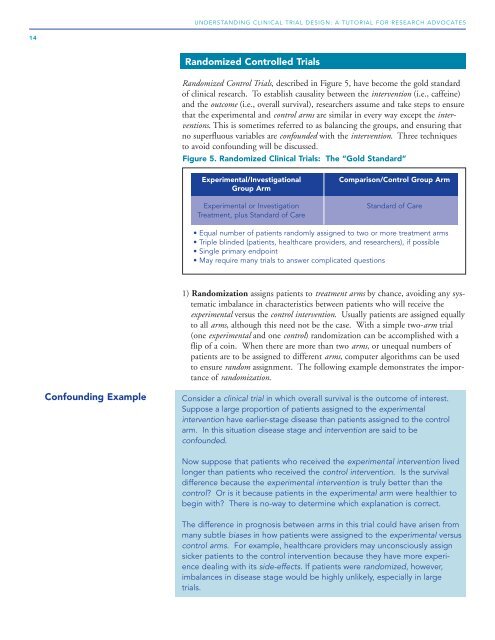Understanding Clinical Trial Design - Research Advocacy Network
Understanding Clinical Trial Design - Research Advocacy Network
Understanding Clinical Trial Design - Research Advocacy Network
You also want an ePaper? Increase the reach of your titles
YUMPU automatically turns print PDFs into web optimized ePapers that Google loves.
14<br />
Confounding Example<br />
UNDERSTANDING CLINICAL TRIAL DESIGN: A TUTORIAL FOR RESEARCH ADVOCATES<br />
Randomized Controlled <strong>Trial</strong>s<br />
Randomized Control <strong>Trial</strong>s, described in Figure 5, have become the gold standard<br />
of clinical research. To establish causality between the intervention (i.e., caffeine)<br />
and the outcome (i.e., overall survival), researchers assume and take steps to ensure<br />
that the experimental and control arms are similar in every way except the interventions.<br />
This is sometimes referred to as balancing the groups, and ensuring that<br />
no superfluous variables are confounded with the intervention. Three techniques<br />
to avoid confounding will be discussed.<br />
Figure 5. Randomized <strong>Clinical</strong> <strong>Trial</strong>s: The “Gold Standard”<br />
Experimental/Investigational<br />
Group Arm<br />
Experimental or Investigation<br />
Treatment, plus Standard of Care<br />
Comparison/Control Group Arm<br />
Standard of Care<br />
• Equal number of patients randomly assigned to two or more treatment arms<br />
• Triple blinded (patients, healthcare providers, and researchers), if possible<br />
• Single primary endpoint<br />
• May require many trials to answer complicated questions<br />
1) Randomization assigns patients to treatment arms by chance, avoiding any systematic<br />
imbalance in characteristics between patients who will receive the<br />
experimental versus the control intervention. Usually patients are assigned equally<br />
to all arms, although this need not be the case. With a simple two-arm trial<br />
(one experimental and one control) randomization can be accomplished with a<br />
flip of a coin. When there are more than two arms, or unequal numbers of<br />
patients are to be assigned to different arms, computer algorithms can be used<br />
to ensure random assignment. The following example demonstrates the importance<br />
of randomization.<br />
Consider a clinical trial in which overall survival is the outcome of interest.<br />
Suppose a large proportion of patients assigned to the experimental<br />
intervention have earlier-stage disease than patients assigned to the control<br />
arm. In this situation disease stage and intervention are said to be<br />
confounded.<br />
Now suppose that patients who received the experimental intervention lived<br />
longer than patients who received the control intervention. Is the survival<br />
difference because the experimental intervention is truly better than the<br />
control? Or is it because patients in the experimental arm were healthier to<br />
begin with? There is no-way to determine which explanation is correct.<br />
The difference in prognosis between arms in this trial could have arisen from<br />
many subtle biases in how patients were assigned to the experimental versus<br />
control arms. For example, healthcare providers may unconsciously assign<br />
sicker patients to the control intervention because they have more experience<br />
dealing with its side-effects. If patients were randomized, however,<br />
imbalances in disease stage would be highly unlikely, especially in large<br />
trials.


